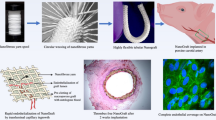Abstract
Purpose
To determine whether fibril length is correlated with graft healing as well as cellular and capillary ingrowth in a canine carotid implantation model.
Methods
Expanded polytetrafluoroethylene (ePTFE) vascular grafts with three different fibril lengths (30, 60, and 90 µm) were implanted into the carotid artery in dogs. They were retrieved 4 weeks later, and subjected to histomorphometric analysis.
Results
Endothelial healing was best in the 60-µm grafts. Not only cellular ingrowth but also capillary ingrowth was most evident in the 60-µm grafts, followed by the 90-µm grafts and then the 30-µm grafts.
Conclusion
Better endothelial healing of ePTFE vascular grafts is correlated with more cellular and capillary ingrowth, but more cellular and capillary ingrowth is not correlated with longer fibril length or higher air porosity.
Similar content being viewed by others
Author information
Authors and Affiliations
Rights and permissions
About this article
Cite this article
Hazama, K., Miura, H., Shimada, T. et al. Relationship Between Fibril Length and Tissue Ingrowth in the Healing of Expanded Polytetrafluoroethylene Grafts. Surg Today 34, 685–689 (2004). https://doi.org/10.1007/s00595-004-2774-9
Received:
Accepted:
Issue Date:
DOI: https://doi.org/10.1007/s00595-004-2774-9




